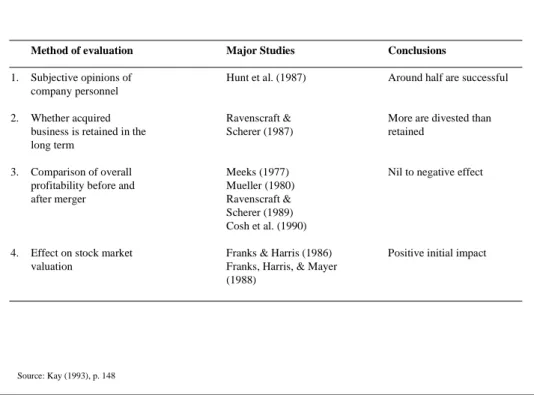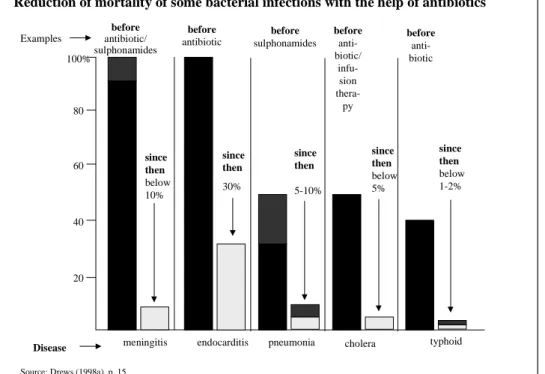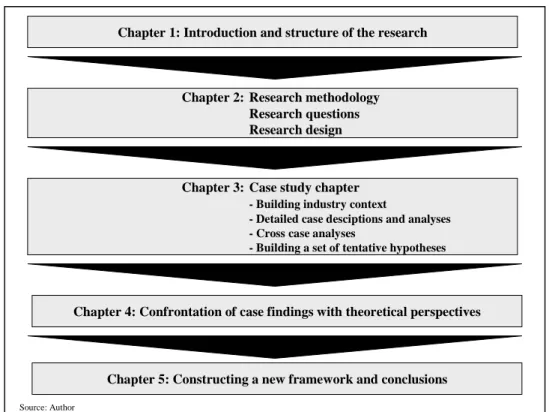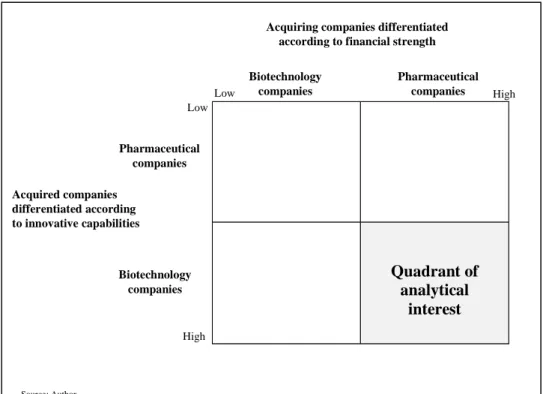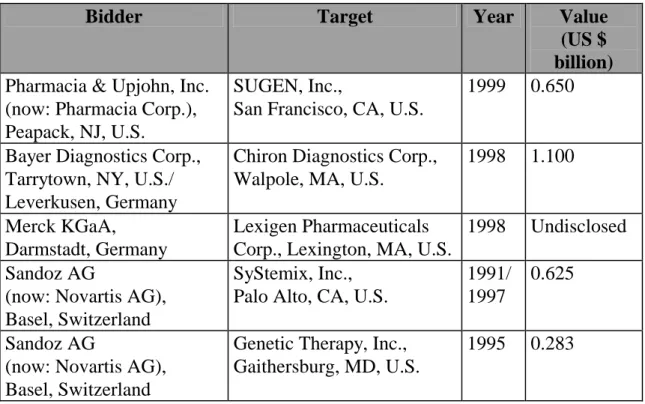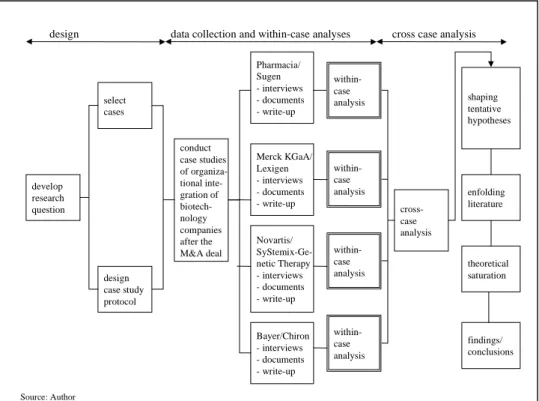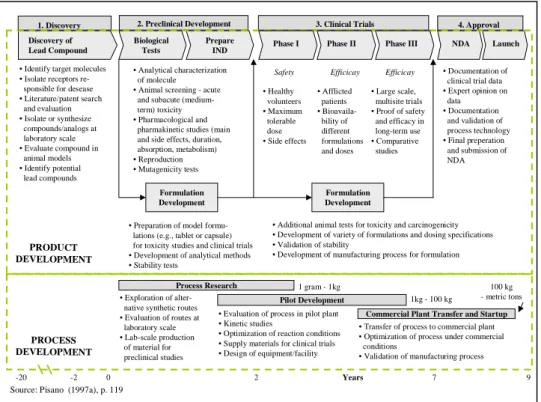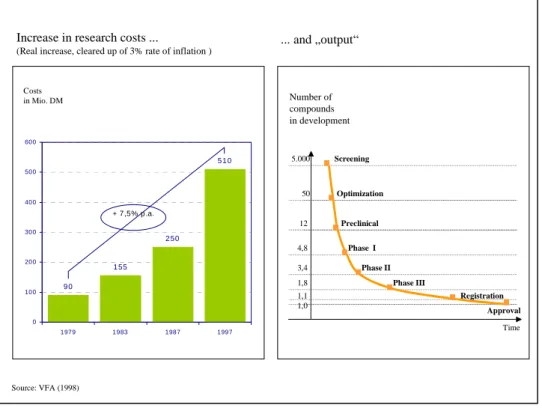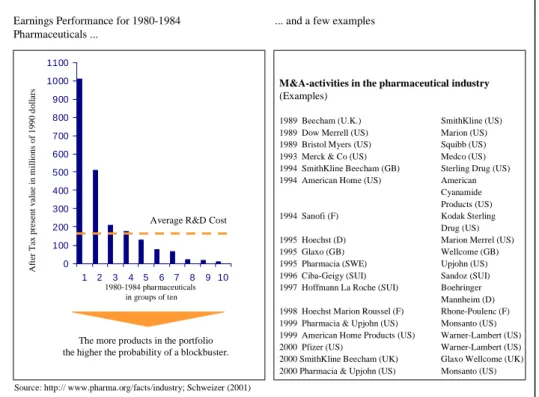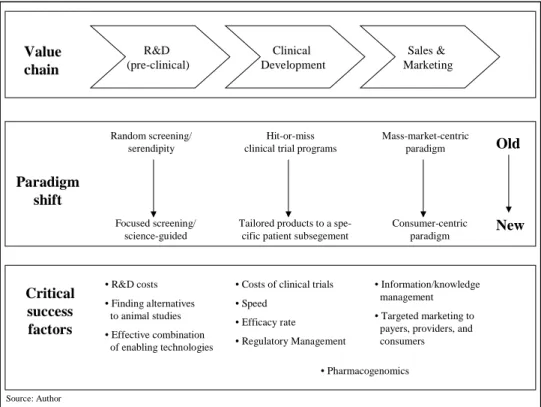P
OST-
ACQUISITION INTEGRATION OF SMALL BIOTECHNOLOGY FIRMS IN THE STRUCTURE OF LARGE PHARMACEUTICAL COMPANIESInauguraldissertation zur Erlangung des Grades eines
doctor rerum politicarum (Dr. rer. pol.) an der Fakultät Sozial- und Wirtschaftswissenschaften der Otto-Friedrich-Universität Bamberg
vorgelegt von Lars Schweizer
am 10. Oktober 2001
Gutachter:
Erstgutachter: Prof. Dr. Dodo zu Knyphausen-Aufseß Zweitgutachter: Prof. Dr. Johann Engelhard
Tag der Promotion: 21. Februar 2002
Bamberg: Universität, Diss., 2002
Table of contents
page
1 Introduction and structure of the research ... 1
2 Research methodology... 13
2.1 Research question and methodology ... 13
2.2 Research design ... 23
3 Case studies of organizational integration of biotechnology companies after the M&A deal ... 29
3.1 Building industry context... 31
3.1.1 The pharmaceutical industry ... 31
3.1.2 The biotechnology industry... 42
3.1.3 The inevitable need for M&A... 58
3.2 The case of Pharmacia Corp. - SUGEN, Inc. ... 71
3.2.1 Case description ... 76
3.2.2 Within-case analysis ... 87
3.3 The case of Merck KGaA - Lexigen Pharmaceuticals Corp.. ... 93
3.3.1 Case description ... 96
3.3.2 Within-case analysis ... 106
3.4 The case of Novartis AG - SyStemix, Inc./Genetic Therapy, Inc. ... 113
3.4.1 Case description ... 117
3.4.2 Within-case analysis ... 130
3.5 The case of Bayer Diagnostics Corp. - Chiron Diagnostics Corp. ... 140
3.5.1 Case description ... 144
3.5.2 Within-case analysis ... 153
3.6 Cross-case analyses and building a set of tentative hypotheses ... 163
4 Theoretical perspectives of the post-acquisition integration and collaboration process... 185
4.1 Confronting extant M&A theories with the case findings... 186
4.2 Confronting extant post-merger literature with the case findings.. ... 198
4.2.1 Determination and concepts of the overall integration strategy ... 199
4.2.2 Discussion of the different organizational integration topics ... 222
4.2.2.1 Organizational collaboration after the acquisition... 222
4.2.2.2 Aspects of knowledge and competence transfer after the acquisition... 228
4.2.2.3 Cultural issues in the context of the post-acquisition integration strategy... 242
4.2.2.4 Human resources related issues of the post-acquisition integration process ... 251
4.3 Discussion of the organization of the post-acquisition integration process.. ... 259
5 Constructing a new approach and directions for further research ... 267
5.1 Constructing a new approach... 268
5.1.1 Implications of core competencies and value chain ... 268
5.1.2 Constructing a new approach: Framework for the post-acquisition integration of small high-technology companies in the structure of large corporations ... 272
5.2 Revisiting the tentative hypotheses... 278
5.3 Implications and directions for further research ... 288
References... 292
Summary in German ... 312 Case study database...
(separate volume)
List of figures
page
Figure 1: Performance of mergers ... 2
Figure 2: Contributions of pharmaceutical discoveries... 5
Figure 3: Structure of the study ... 12
Figure 4: Classification matrix for M&A activities in the pharmaceutical and biotechnology industry... 20
Figure 5: Research outline of the study about post-acquisition integration activities... 28
Figure 6: Research and development process for a new drug ... 33
Figure 7: Development of research costs in the pharmaceutical industry... 36
Figure 8: Earnings pressure and M&A activities in the pharmaceutical industry... 37
Figure 9: Transformation process in the pharmaceutical industry ... 40
Figure 10: Three generations of biotechnology... 44
Figure 11: Biotechnology value chain for human health care... 50
Figure 12: Potential developments of the interplay between biotechnology and pharmaceutical companies ... 59
Figure 13: Valuations of mergers and acquisitions involving biotechnology companies ... 62
Figure 14: M&A activities in the biotechnology and pharmaceutical industry ... 63
Figure 15: New alliances between pharmaceutical and biotechnology companies... 67
Figure 16: Geographic distribution of pharmaceutical partners for biotechnology companies . 68 Figure 17: Gradual consolidation of the biotechnology industry through increased M&A activities... 69
Figure 18: The seamless product flow system of Pharmacia ... 73
Figure 19: Merck’s organizational structure ... 94
Figure 20: History of Lexigen ... 96
Figure 21: Bayer AG organization... 142
Figure 22: Industry-life-cycle-model ... 190
Figure 23: Trautwein’s theories of merger motives ... 194
Figure 24: Post-merger integration tasks ... 204
Figure 25: Framework for post-merger integration management... 207
Figure 26: Types of acquisition integration approaches... 211
Figure 27: Different types of subsidiary strategy ... 219
Figure 28: Managing innovations in the transnational organization ... 221
Figure 29: The most commonly used mechanisms of coordination ... 227
Figure 30: Four generic types of international R&D and innovation... 233
Figure 31: Types of corporations and their dominant patterns of innovation ... 234
Figure 32: Determinants of the rate and direction of firm level innovation... 237
Figure 33: Matrix of innovation, capabilities and preferred organizational forms ... 239
Figure 34: The acquired firm’s preferred adaptation process ... 247
Figure 35: The acquiring firm’s preferred adaptation process... 248
Figure 36: Common planning model for the integration process ... 260
Figure 37: Steps of the post-merger process... 262
Figure 38: Detailed steps of the post-merger integration process ... 263
Figure 39: The generic value chain ... 271
Figure 40: Post-acquisition integration framework ... 273
List of tables
page
Table 1: Sample of major M&A deals ... 23
Table 2: M&A deals valued more than $100 million in 1998... 64
Table 3: M&A deals valued more than $100 million in 1999... 65
Table 4: M&A deals valued more than $100 million in 2000... 66
Table 5: Classified summary of the tentative hypotheses ... 280
List of acronyms
ADR American depository receipt
AG Aktiengesellschaft [corporation]
AIDS Acquired Immune Deficiency Syndrome BCG Boston Consulting Group
BIO Biotechnology Industry Organization CA California
CEO Chief Executive Officer CFO Chief Financial Officer
CHF Swiss Franc
Corp. Corporation CRO Clinical Research Organization DBF Dedicated Biotechnology Firm
Dipl.-Kfm. Diplom-Kaufmann [Master of Science in Business Administration]
DNA Deoxyribonucleic acid
e.g. for example
EASDAQ European association of securities dealers automated quotation ed. Edition
Ed. Editor
ELISCO Entrepreneurial life science company
EU European Union
FDA Food and Drug Administration GTI Genetic Therapy, Inc.
HTTP Hypertext transport protocol
i.e. That is
Inc. Incorporated IPO Initial public offering
KGaA Kommanditgesellschaft auf Aktien [Limited partnership on shares]
M&A Mergers and Acquisitions
M.B.A. Master of Business Administration MA Massachusetts MD Maryland NAD Nucleic Acid Diagnostic
NASDAQ National association of securities dealers automated quotation NBF New Biotechnology Firm
NC North Carolina
NJ New Jersey
OECD Organization for Economic Cooperation and Development OTA Office of Technology Assessment
OTC Over-the-counter R&D Research and Development
RDNA Recombinant deoxyribonucleic acid
S.A. Société Anonyme [corporation]
SEC Security and Exchange Commission SIC Standard Industrial Classification
U.K. United Kingdom
U.S. United States
VFA Verband Forschender Arzneimittelhersteller e.V.
Vol. Volume
VP Vice President
WWW world wide web
1 Introduction and structure of the research
“We know surprisingly little about mergers and acquisitions, despite the buckets of ink spilled on the topic. In fact, our collective wisdom could be summed up in a few short sentences: acquirers usually pay too much. Friendly deals done using stock often perform well. CEOs fall in love with deals and don’t walk away when they should. Integration’s hard to pull off, but a few companies do it well consistently.” (Bower, 2001, p. 93)
Mergers and acquisitions are among the most dramatic and visible manifestations of strategy at the corporate level. With a single deal, the strategic course of the organizations involved can be altered permanently. Acquirers can gain immediate access to technologies, products, distribution channels, personnel and desirable cost and market positions. Moreover, acquisitions can bring into a company capabilities the organization finds hard to develop and can also provide the opportunity to leverage existing capabilities into much more significant positions.
The M&A phenomenon shows no signs of slowing and has even embraced the high-technology sectors where it was formerly rare. M&A is increasingly becoming a more integral part of business life. The idea of ‘mega deals’ is haunting the top floors of the world’s largest companies. Every day new deals are announced, and various stakeholders greet them with reactions ranging from euphoria to skepticism.
•
On the 4
thof September, 2001 Hewlett Packard (HP) has announced the acquisition of Compaq in a deal worth $21.4 billion.
•
In 2000, Vodafone AirTouch has acquired the German telecommunications and engineering Group Mannesmann in a deal worth $173.25 billion.
•
Since 1992, Tyco International has acquired and integrated more than 110 companies.
•
Between 1993 and 2000, Cisco Systems has made 65 acquisitions of small high-tech start-ups with deal amounts between $40 million and $450 million.
Mergers and acquisitions are justified by the extent to which they add value.
Despite the important role which acquisitions play in most discussions of
corporate strategy, a harsh reality underlies the M&A activities, whether it be high- or low-technology industries: more than half of these transactions fail. Kay (1993) has summarized major studies about the performance of mergers and acquisitions and has come to the overall conclusion that “taken as a whole, merger activity adds very little value” (Kay, 1993, p. 146). The following Figure 1 provides an overview of the studies considered by Kay (1993).
Figure 1: Performance of mergers
However, none of this evidence should be interpreted as indicating that no merger is ever successful. But, it is necessary to ask why do mergers perform poorly or even do fail completely. A recent study of McKinsey (Bekier, Bogardus &
Oldham, 2001) has pointed out that many companies lose their revenue momentum after the acquisition as they concentrate on cost synergies or fail to focus on post-merger growth in a systematic manner. In fact, only 12% of the companies in the sample of the McKinsey study managed to accelerate their growth significantly over the three years following the merger. A study of A.T.
Kearney has come to the conclusion that the post-merger integration phase bears the greatest risk in an acquisition (Habeck, Kröger & Träm, 2000). This point of view is corroborated by a study of Bain (Duelli, 2000), which revealed that more than half of all merger and acquisition failures are caused by faulty post- merger/post-acquisition integration activities. Besides a fragmented perspective
Method of evaluation Major Studies Conclusions
1. Subjective opinions of Hunt et al. (1987) Around half are successful company personnel
2. Whether acquired Ravenscraft & More are divested than
business is retained in the Scherer (1987) retained
long term
3. Comparison of overall Meeks (1977) Nil to negative effect
profitability before and Mueller (1980)
after merger Ravenscraft &
Scherer (1989) Cosh et al. (1990)
4. Effect on stock market Franks & Harris (1986) Positive initial impact
valuation Franks, Harris, & Mayer
(1988)
Source: Kay (1993), p. 148
and unresolved expectations, Jemison & Sitkin (1986b) identify the limited consideration of integration issues as one of the major reasons for unsuccessful M&A activities. The second major reason that is often discussed in this context is the overestimation of potential synergies that are supposed to result out of an acquisition (Sirower, 1997; Coenenberg, 1988; Chatterjee, 1986). However, Buono & Bowditch (1989) have pointed out that
“because of the myriad questions about merger and acquisition success, attention has begun to shift toward human resource concerns, the cultural ramifications of merger activity, management of overall combination process, and specific efforts aimed at post-combination integration”. (Buono & Bowditch, 1989, p. 10)
Furthermore, a study of Chakrabarti (1990) has found that post-merger performance depends even more on post-merger integration than on strategic fit, because organizational factors intervene and essentially determine which of the pre-merger potentials are really achieved and which are not.
Although there is a lot of literature from strategy researchers or financial economists in which M&A activities have been analyzed from different perspectives, the issue of post-merger integration is still a rather neglected one.
Some of these studies have been done in the context of the market for corporate control (Jensen & Ruback, 1983; Jarrell, Brickley & Netter, 1988), whereas others have investigated the specific performance or success of the acquiring/acquired company, sometimes also linked to a specific type of acquisition (Seth, 1990a & 1990b; Ansoff et al., 1971; Möller, 1983; Agrawal, Jaffe & Mandelker, 1992; Lubatkin, 1983; Shelton, 1988; Ahuja & Katila, 2001).
Another set of studies has coped with the broader question, whether mergers and acquisitions do create value under the influence of certain variables (Schmush, 1998; Jarrell & Poulsen, 1994; Datta, 1991; Healy, Palepu & Ruback, 1992;
Markides & Oyon, 1998; Rad & Beek, 1999; Fowler & Schmidt, 1989; Shanley
& Correa, 1992; Datta, Pinches & Narayanan, 1992; Lubatkin, 1987), or of which steps the M&A process should consist (Jansen 1998; Gomez & Weber, 1989;
Ivancewich, Schweiger & Power, 1987; Hunt & Downing, 1990; Kübler, 1996).
Despite this broad body of literature, the issue of post-merger integration, which
is closely linked with the complex organizational implications of acquisitions, has
been rather widely neglected. This fact has already been pointed out with the introductory quotation of Bower (2001). In addition to that, some other authors (Shrivastava, 1986; Napier, 1989; Hunt & Downing, 1990; Gerpott, 1993;
Chakrabarti, 1990; Seed III, 1974; Davidson & Neumann, 1997; Haspeslagh &
Jemison, 1987 & 1991; Deiser, 1994; Walsh, 1989; Inkpen, Sundaram &
Rockwood, 2000) also emphasize the importance of the post-acquisition integration strategy and support the need for further research in this context:
“Improving the acquisition integration process, however, may be one of the most urgent and compelling challenges facing business today.” (Ashkenas, DeMonaco
& Francis, 1998, p. 166)
Already almost 40 years ago Mace & Montgomery (1962) stated the following:
“The values to be derived from an acquisition depend largely upon the skill with which the administrative problems of integration are handled. Many potentially valuable acquired corporate assets have been lost by neglect and poor handling during the integration process.” (Mace & Montgomery, 1962, p. 230)
After having seen, that mergers and acquisitions have become an integral part of business life, on the one hand, and that more than half of mergers and acquisitions fail, primarily because of a poor post-merger or post-acquisition integration strategy, on the other hand, this study will put its analytical focus on the post-acquisition integration of small biotechnology companies into the structure of big pharmaceutical companies. The two questions that arise now are:
(1) Why is it necessary to focus on the post-acquisition integration issues between pharmaceutical and biotechnology companies? (2) What contributions can this analysis make to the topic of post-merger integration?
To start with, biotechnology is one of the most important technologies to have
emerged over the last twenty years. Today, this growing industry comprises a
range of companies from research-focused start-ups to mid-size companies with
manufacturing capability and large pharmaceutical companies. Along with
information technology and new materials technology, it is, in fact, considered to
be one of the ‘generic’ technologies which will underpin much future industrial
growth. Hence, biotechnology’s novelty and scope inevitably cause considerable
turbulence and changes within firms, and, particularly, in the relationships
between firms relying on it. The rapid changes in the pharmaceutical industry occurring as a result of biotechnology’s development provide the context of this study. One important question is why these two industries are of such high analytical interest. The simplest and also most obvious answer lays in the most fundamental need of mankind: the will to survive. The discoveries of the pharmaceutical and biotechnology companies help to reduce mortality and to prolong life. This can surely be considered as one of the most important needs, if not the need of all human beings. Some contributions pharmaceutical discoveries have already achieved are indicated in Figure 2:
Figure 2: Contributions of pharmaceutical discoveries
Apart from that, the pharmaceutical industry is undergoing a consolidation process. This process is characterized by M&A activities between large pharmaceutical companies such as SmithKline Beecham and Glaxo Wellcome, on the one hand, and the acquisition of small biotechnology companies like Sugen by Pharmacia, on the other hand.
1The merger activities between pharmaceutical companies are primarily motivated either by achieving operational improvements or by getting a specific product. In contrast to this, the
1 These issues will be discussed in more detail in Chapter 3.
Reduction of mortality of some bacterial infections with the help of antibiotic
typhoid cholera
pneumonia endocarditis
meningitis Disease
100%
80
60
40
20
since then below 1-2%
since then below 5%
since then
5-10%
since then 30%
since then below 10%
before antibiotic/
sulphonamides
before antibiotic
before sulphonamides
before anti- biotic/
infu- sion thera-
py
before anti- biotic Examples
Source: Drews (1998a), p. 15
Reduction of mortality of some bacterial infections with the help of antibiotics
typhoid cholera
pneumonia endocarditis
meningitis Disease
100%
80
60
40
20
since then below 1-2%
since then below 5%
since then
5-10%
since then 30%
since then below 10%
before antibiotic/
sulphonamides
before antibiotic
before sulphonamides
before anti- biotic/
infu- sion thera-
py
before anti- biotic Examples
Source: Drews (1998a), p. 15
acquisition of biotechnology companies takes place, because the pharmaceutical companies want to get access to the knowledge and research capabilities embedded in the biotechnology companies. Thus, pharmaceutical companies are involved in a multitude of M&A activities that demand a great variety and combination of different skills and concepts which could also be very interesting for other industries.
The title of this study – ‘Post-acquisition integration of small biotechnology firms into the structure of large pharmaceutical companies’ – points out the further analytical focus. The emphasis will be put on how a smooth organizational integration of the biotechnology companies into the organizational structure of pharmaceutical companies can be ensured in order not to endanger the innovative capabilities and the loss of the key knowledge holders at the biotechnology companies. Pharmaceutical companies have a severe problem when facing the need to integrate an acquired biotechnology company. On the one hand, they need to integrate the biotechnology company to some extent in order to be able to profit from the capabilities of the newly acquired company. But on the other hand, these capabilities are very context-specific and cannot simply be transferred from the biotechnology company to the pharmaceutical company. Thus, the pharmaceutical companies face the paradox, that they need to integrate the biotechnology companies in some way in order to get access to the desired capabilities, whereas, on the other hand, they need to preserve the autonomy of the biotechnology company in order not to endanger the future existence of the desired capabilities.
2This study will analyze how pharmaceutical companies have handled this paradox by investigating five different M&A case studies with special regard to their specific post-acquisition integration activities.
2 Zaby (1999) analyses the international biotechnology activities of Bayer AG. In this context some aspects are very interesting for this study. In 1978, Bayer acquired Miles Laboratories that also had a small presence in West Haven, Connecticut, close to Yale University in New Haven. Bayer entered into a joint venture with a group of young professors from Yale University in order to learn from the organizational structure of a biotechnology company which was a novel concept for European pharmaceutical companies at that time. However, Bayer was not able to sustain the entrepreneurial spirit of the biotechnology company during the cooperative phase and even much less after the full acquisition and integration of the joint venture into Miles Laboratories.
Therefore, the goal of this study is to shed light on this phenomenon, to explore how a successful post-acquisition integration between small start-ups and large corporations can be realized in the specific context of a knowledge-intensive, innovation-driven and capability-focused high-technology industry. Because the few existing studies about post-merger integration, such as e.g. Haspeslagh &
Jemison (1991) or Shrivastava (1986), have not yet analyzed this paradox, this study tries to close that gap by providing a framework for the integration of small high-technology companies into the structure of large corporations. Such research is explorative in nature, because not enough is known about the post-acquisition relationships between small biotechnology firms and large pharmaceutical companies in order to perform large-scale hypotheses testing research using quantitative analysis. Instead, this study aims at developing a set of rigorously formed hypotheses that have the potential to extend extant post-merger and post- acquisition theory and that lend themselves to subsequent tests. The overall aim of this study is to further the theory of post-acquisition integration by developing a framework for the development of a successful integration strategy of small high-technology companies into the structure of large companies.
Since very little is known about the different post-acquisition activities between biotechnology and pharmaceutical companies, a considerably detailed approach is called for. A contextually rich description of the biotechnology and pharmaceutical industry, of the firms operating in them, and of their M&A activities is needed if a deeper understanding is to be gained. Thus, detailed descriptions are indispensable for eventually creating rich theoretical insights.
Hence, the research approach selected for the purpose of this study is descriptive,
holistic and to some extent also longitudinal. However, it is even more than that,
because this study is also analytic in nature. It does not only ask ‘what’ questions,
it especially asks ‘why’ and ‘how’ questions. The appropriate research
methodology for a study that attempts to extend existing post-merger and post-
acquisition integration literature by description and analyses is the comparative
case study research methodology (Eisenhardt, 1989). This brief introduction of
the methodological foundation may suffice at this point, since Chapter 2 contains
a profound discussion of the selection and the application of the comparative case
study methodology. This section will also explain the research process itself.
Furthermore, one other topic must be considered in the course of this introductory chapter. It is the inevitable topic of terminology, which will be limited to a short, yet concise, explanation of some key terms. In this section, however, there will be no explanations about what is understood by either the biotechnology or the pharmaceutical industry, since this will be done in the context of the respective sections concerned with building industry context (Chapter 3.1). Instead, this section will now focus on a terminological foundation around everything that deals with the terms ‘mergers’ and ‘acquisitions’.
Although the terms ‘mergers’ and ‘acquisitions’ do not describe the same thing, the growing literature in this field suggests that they are homogeneous in nature and typically have the same repercussions for the firms (Schweiger & Ivancevich, 1987). Therefore, the terms ‘mergers’ and ‘acquisitions’ are used interchangeably in most discussions. That is also the approach taken in the context of this study, in which the terms ‘mergers’ and ‘acquisitions’ will be used synonymously.
Nevertheless, it is necessary to point out the specific differences and meanings of these expressions. In a more technical sense, ‘acquisition’ describes any transfer of ownership, whereas ‘merger’ describes a transfer of ownership in which one entity legally disappears into the other, or both entities disappear into a third entity created for the purpose of the merger (Lajoux, 1998). In other situations, the word ‘merger’ is used to mean the union of two companies of substantially equal size involving a high degree of cooperation and interaction, while the word
‘acquisition’ refers to the combination of a large company with a much smaller one.
The difference between mergers and acquisitions, however, tend to be much more than technical and semantic in nature. Mace & Montgomery (1962) found when talking with the executives of a target firm that management representatives of the acquiring company always referred to a ‘merger’ of the two firms, although it was implicit and apparent that the one firm proposed to acquire the other. In the respective situation the negotiating executives of the acquiring company would talk about ‘merger’ with the management of the company to be acquired, but when discussing this opportunity with their board of directors, they referred invariably to the possibility of ‘acquisition’. In the words of Mace &
Montgomery (1962):
“There seemed to be an inoffensive quality in the word ‘merge’ not found in the word acquire. As one executive stated, ‘The reasons for the difference are unclear, but management find comfort in the merging of mutual interests. Being acquired connotes being had!’” (Mace & Montgomery, 1962, pp. 3-4)
For analytical purposes, it is usual to consider mergers and acquisitions in terms of the extent to which the activities of the acquired organizations are related to those of the acquirer. This kind of classification proposes four main types of mergers and acquisitions (Walter, 1985; Hovers, 1973; Kitching, 1967):
•
Vertical M&A is the combination of two organizations from successive processes within the same industry with an actual or potential buyer-seller relationship. In this context, an organization may chose to acquire a supplier (backward integration) or a firm that could distribute its products (forward integration).
•
Horizontal M&A comprises the combination of two similar organizations in the same industry and often occurs, when the firms involved produce one or more of the same or closely related products or services in the same geographic area.
•
Conglomerate M&A occurs when the acquired organization is in a completely unrelated field of business activity. The rationale usually cited for such acquisitions is that the combination opens entry into an attractive business or industry and spreads the company’s risk.
•
Concentric M&A is when the acquired organization is part of an unfamiliar, but related field into which the acquiring company wishes to expand. This kind of M&A activity is often referred to as product extension and occurs, when the acquiring and acquired companies are functionally related in a field, but sell product or services that do compete directly with one another.
Napier (1989) suggests that mergers can also be considered as falling into three main types, depending on the degree of integration necessary, if the merger is to achieve its objectives. These types are described as follows:
•
In extension mergers the acquiring organization does not intend to change,
other than perhaps minimally, the way in which the acquired company
transacts its business. This approach is also referred to as ‘hands off’
approach.
•
In collaborative mergers the success is dependant upon the integration of operations (‘synergy mergers’) or exchange of technology or other expertise (‘exchange mergers’).
•
In redesign mergers the acquiring organization intends to introduce widescale changes, whereby the acquired company totally adopts the practices and procedures of the acquirer.
The terms ‘post-acquisition’ or ‘post-merger integration’ refer primarily to the art of combining two or more companies – not just on paper, but in reality – after they have come under common ownership. Integration refers to a combination of elements that results in wholeness. Moreover, integration occurs at several levels, e.g. by combining the accounting systems of the two firms or by creating a single legal entity. Other important issues may be the integration of physical assets, product lines, production systems, technologies, or the cultural integration. Not all these types of integration are always achieved or even necessary for acquired organizations to function. The necessary degree and fields of integration are determined by a variety of contingencies which will be discussed at a later point of this study. Apart from that, it is necessary to mention that – in the context of this study – the general use of the term ‘integration’ is not able to catch all dimensions, because the ‘integration’ of the small high-technology companies comprises two different aspects. On the one hand, this means the necessary degree of integration of the acquired company into the structure of the acquiring company in order to add value. On the other hand, this refers at the same time to the necessary degree of autonomy for the small high-technology company in order to ensure the future existence of the small company’s capabilities which made the large company acquire it.
One of the key challenges in managing acquisitions is to ensure that acquisitions
support the firm’s overall corporate renewal strategy (Haspeslagh & Jemison,
1991), because in most cases acquisitions are strategic decisions that can both
reinforce and change a firm’s direction. Hence, acquisition decisions must be
consistent with the firm’s strategy. The acquisition activity analyzed in this study
aims at such strategic acquisitions, because all biotechnology acquisitions that were analyzed aimed at reinforcing the current strategy of the acquiring pharmaceutical company.
At this point of the introduction – after having dealt with the most fundamental terminological issues – one might typically expect a section that deals with an overview of the existing literature. However, in the context of an exploratory study – like this – the recommendations of leading case study methodologists are different. They favor an ideal of theory free research (Eisenhardt, 1989 & 1991;
Yin, 1984; Dyer & Wilkins, 1991) – however feasible this in reality may be. Due to these recommendations, the subsequent chapter (Chapter 2) leads directly to the research methodology and Chapter 3 to the description of the pharmaceutical and biotechnology industry as well as the different case studies.
The focus of this study was chosen to better understand what happened when pharmaceutical companies acquired biotechnology companies and subsequently had to decide about the transfer of skills, knowledge, resources, and ways of managing to improve their relative competitive position with respect to their newly acquired business. Analyzing these post-acquisition integration activities involves a lot of time and energy, and also requires attention to detail. This study leads to a framework for the post-acquisition integration of small high-technology companies into the structure of large corporations as well as insights into the integration problems that managers of pharmaceutical and biotechnology companies encounter when they try to combine their activities.
This study is organized as follows (cf. Figure 3): Before the cases can be
presented, a set of research questions must be specified that guide the entire
research process from field work to case description and analysis to theory
extension. Thus, the necessary formulation of these questions will be done in the
following Chapter 2, which also introduces the research methodology and
research design of this study. Chapter 3 deals with the profound description and
analyses of the cases embedded in their industry context. Only after a rich and
theoretically unbiased understanding of the post-acquisition integration activities
has been gained, extant theories are confronted with the case findings (Chapter
4). The frequently propagated procedure of postponed literature review will lead
to the extension of theory and contribute to the construction of a new framework (Chapter 5).
Figure 3: Structure of the study
Source: Author
Chapter 1: Introduction and structure of the research
Chapter 2: Research methodology Research questions Research design
Chapter 3: Case study chapter - Building industry context
- Detailed case desciptions and analyses - Cross case analyses
- Building a set of tentative hypotheses
Chapter 5: Constructing a new framework and conclusions Chapter 4: Confrontation of case findings with theoretical perspectives
2 Research methodology
“For the most part, the cases of interest in education and social service are people and programs. Each one is similar to other persons and programs in many ways and unique in many ways. We are interested in them for both their uniqueness and commonality. We seek to understand them. We would like to hear their stories.”
(Stake, 1995, p. 1)
This chapter starts with explaining the research methodology of this study. This explanation draws on the writings of several case study research methodologists and demonstrates the actual application of their recommendations in a real-life study. Section 2.1 aims at being of value to the reader in evaluating the methodological foundation of this study. The subsequent section (2.2) concentrates on the particular research design of this study.
2.1 Research question and methodology
The research of this study starts from a perceived inappropriateness of existing studies in the field. In the context of post-acquisition integration activities, where testable theoretical propositions have not been sufficiently developed, the paradigm of critical rationalism, as proposed for example by Popper (1976), seems inappropriate. This paradigm considers the purpose of scientific research as explaining reality by formulating theories and then attempting to falsify them (Kretschmann, 1990). However, falsification is hardly possible when relatively few hypotheses on a phenomenon have been stated. Thus, for this study, theory- building using mainly qualitative research is much more appropriate than theory- testing (Eisenhardt, 1989; Snow & Thomas, 1994).
3Qualitative research has become increasingly accepted in disciplines such as psychology, sociology and business administration (Miles & Huberman, 1994).
3 E.g., Gioia & Pitre (1990) argue for a multiparadigm approach to theory building as a means of establishing correspondence between paradigms and theory-construction efforts.
From their point of view, qualitative research corresponds to ‘theory-building in the interpretative paradigm’, whereas quantitative research is viewed as ‘theory-building in the functionalist paradigm’.
Moreover, qualitative and quantitative research differ in more than their research methodology and data analysis. On the one hand, qualitative research is often characterized as interpretative, whereas quantitative research is considered as being positivist. Thus, regarding qualitative research as interpretative might even imply that quantitative research is not interpretative. Although the selection of specific variables as likely causes of some designated effects, the formulation of hypotheses, and the use of statistics might create this impression, the design of the research strategy as well as the subsequent interpretation of the collected data have both interpretative aspects (Eisenhardt & Bourgeois III, 1988).
Because of convenience – and perhaps of an aura of rigor – there is an undeniable temptation to conduct cross-sectional research that ”proceeds from a distance, with a remote researcher gathering abstract data from organizations he knows almost nothing about” (Miller & Friesen, 1982, p. 1014). This study takes a different approach.
”Longitudinal research seems to enable us to obtain a sounder understanding of organizations. It puts us in a better position to establish causal relationships, to take into account the most important variables, and to ensure that we do not overgeneralize by lumping very different organizations together.” (Miller &
Friesen, 1982, p. 1014)
With the help of within-case and cross-case analyses the goal is pursued to find diverging as well as similar patterns of integration activities on the basis of which tentative hypotheses can be formed. The end result – a set of tentative hypotheses – represents the actual goal of this case study’s work describing and comparing several integration processes. This study’s longitudinal aspect stems from the fact that the aim is to ‘reconstruct’ the acquisition and especially the post-acquisition integration process between biotechnology and pharmaceutical companies.
According to Yin (1984) “defining the research question is probably the most important step to be taken in a research study” (p. 19). Stake (1995) refers to the
‘research question’ also as ‘issue question’ or ‘issue statement’. The central research question of this study focuses on how the post-acquisition integration between biotechnology companies and big pharmaceutical companies takes place.
In this context, it is necessary to consider what consequences this implies for the
knowledge transfer and the organizational changes that might affect the
innovative and organizational competencies and flexibility of the acquired company. In analyzing and trying to answer this question the following research fields, which can also be considered as kind of sub-research questions, which Stake (1995) refers to as ‘topical questions’, are of great interest:
1. the impact of motives, sequence and timing of the M&A process on the integration process,
2. the analysis of the integration process itself with respect to the dimensions of:
- strategic integration,
- organizational/structural integration, - knowledge/competence transfer, - cultural integration,
- personnel/HR integration, as well as
3. the organization of the integration process itself.
The set of research questions guides the entire research process from field work to case description over analysis to theory extension. Moreover, it helps the investigator to specify the kind of organization to be approached, and the kind of data to be gathered. The formulation of the research question is crucial, because, on the one hand, the researcher may risk to become overwhelmed by the complexity of the data with questions that are too broad and general in nature, and, on the other hand, with questions that are too focused, too specific the issue of bias reappears. In such a dilemma situation a carefully compromising solution appears appropriate and, in fact, is proposed by Eisenhardt (1989). The research questions need to serve as ‘guiding lights’ without overly restricting the necessary degrees of freedom of the research process. In Mintzberg’s (1979) words:
“No matter how small our sample or what our interest, we have always tried to go into organizations with a well-defined focus − to collect specific kinds of data systematically.” (Mintzberg, 1979, p. 585)
A contextually rich description of the biotechnology as well as the
pharmaceutical industry, of the firms operating in them, and of their M&A
activity is needed if a deeper understanding is to be gained. Thus, detailed
descriptions or ‘stories’ are indispensable for eventually creating rich theoretical
insights, even if this means that researchers have to collect seemingly
circumstantial technical information on the industries or companies they are observing in a time consuming effort. Piore (1979) points out that each information collected in the case study process can be considered as a certain piece of pattern of these cases.
Due to the fact, that this study does not only ask ‘what’ questions, but it also asks
‘why’ and ‘how’ questions, it can also be considered analytic in nature. The appropriate research methodology for a study that attempts to extend theory by description and analysis, that describes in detail ‘what’ M&A activity of the pharmaceutical companies in the biotechnology sector exists, that analyzes ‘why’
the observed integration patterns occur, and that analyzes ‘how’ the described behavior unfolds regarding both the forms and the sequences it takes on, is the comparative case study research methodology (Eisenhardt, 1989).
The choice for this research strategy is also supported by the work of Yin (1984), who distinguishes five research strategies: experiments, surveys, archival analyses, history, and case studies. From his point of view there are three basic conditions that determine the selection of an appropriate strategy for a study: (1) the types of research questions, (2) the extent of control an investigator has over actual behavioral events, and (3) the degree of focus on contemporary as opposed to historical events. This study asks ‘how’ and ‘why’ questions which are more explanatory in nature and thus – according to Yin (1984) – favor the use of case studies as the appropriate research strategy. Moreover, he also points out that the case study’s unique strength is its ability to deal with a full variety of evidence – documents, artifacts, interviews, and observations.
As in all exploratory studies of this kind, the case chapter is not only the longest chapter – it must also be considered as being the ‘heart and soul’ of the research.
The goal is to develop a rich, complicated understanding of the integration of the
biotechnology enterprises in the structure of the industry incumbents through the
description and analyses of the different integration histories. Why the case study
approach is chosen can best be expressed in the words of Stake (1995):
“We study a case study when it itself is of very special interest. We look for the detail of interaction with its contexts. Case study is the study of the particularity and complexity of a single case, coming to understand its activity within important circumstances.” (Stake, 1995, p. xi)
The study is directed at the integration process of small biotechnology companies in the structure of industry incumbents and the subsequent collaboration between them. The aim is to generate hypotheses and to extend theory in this field. Thus, the selection of an appropriate research methodology – such as the case study approach – is necessary. Of course, it is widely accepted that qualitative data are most appropriate for generating an initial understanding of the rationale or theory of a process. After that, the results can be tested by quantitative support (Eisenhardt, 1989). But, with a research focus that seeks to grasp the ‘how’ and
‘why’ of processes a story that narrates the sequence of events is absolutely needed (Van de Ven & Huber, 1990).
Yin (1984) mentions three major concerns a case study strategy has to deal with.
First, there is the complaint about the lack of rigor of case study research. Thus, every investigator must work hard in order to ensure methodological rigor, which for example can be realized through the help of well-identified research questions as well as well-developed interview schedules and questionnaires (Eisenhardt, 1991). Taking this into account, the problems in case study research are not different from experiments, surveys or historical research. In this context, Yin (1984) mentions that “much depends on an investigator’s own style of rigorous thinking, along with the sufficient presentation of evidence and careful consideration of alternative interpretation” (p. 105). Second, there is the frequently asked question of how to generalize from just one case. According to Yin (1984) the answer is that
“case studies, like experiments, are generalizable to theoretical propositions and not to populations or universes. In this sense, the case study, like the experiment, does not represent a ‘sample’, and the investigator’s goal is to expand and generalize theories (analytic generalization) and not to enumerate frequencies (statistical generalization)”. (Yin, 1984, p. 21).
The third concern about case studies is that they take too long and result in
massive, unreadable documents. This represents another challenge for the
investigator who has to look for alternative ways of getting information. He could for example make more use of the telephone or the data available in libraries instead of being a participant-observator. Moreover, he should keep in mind who the audience of the case study is going to be.
Eisenhardt (1989) emphasizes that “theory-building research is begun as close as possible to the ideal of no theory under consideration and no hypotheses to test”
(p. 536). Because of this, the third chapter leads directly to the cases and the contextual descriptions of the industries of which the regarded companies are part. After a rich and theoretically unbiased understanding of the organizational integration activities has been gained, there will be the confrontation of theories and case results. This procedure of ‘postponed’ literature review will lead to the extension of theory and thus to a theoretical contribution of its own. Of course, even Eisenhardt (1989) must admit that “it is impossible to achieve this ideal of a clean theoretical slate” (p. 536). Thus, her advice is that the case study researcher
“should avoid thinking about specific relationships between variables and theories as much as possible” (Eisenhardt, 1989, p. 536). And, that is exactly the approach this study is going to take.
Another crucial issue is to choose the right numbers of case studies. According to Eisenhardt (1991) it is important to notice that “the appropriate number of cases depends upon how much is known and how much new information is likely to be learned from incremental cases” (p. 622). Comparing this with her former statement, Eisenhardt (1989), this must somehow be seen in relative terms:
“A number of 4 to 10 usually works well. With fewer than 4 cases, it is often difficult to generate theory with much complexity, and its empirical grounding is likely to be unconvincing.” (Eisenhardt, 1989, p. 545)
Considering both statements, one may even draw the conclusion that every
number of case study is right as long as new insights are gained. This study
investigates the M&A and organizational integration activities of four
pharmaceutical firms as well as their subsequent collaboration with the acquired
company. The study is intentionally focused on this small number of enterprises
in order to allow a detailed analysis and contextually rich description of the
complex processes. Moreover, this study is limited to five cases because of the
given time and particularly the funding restraints. Having to choose between more cases and richer context this study tries to put its emphasis on a more contextualist research which, according to Pettigrew (1990), is more capable of capturing the embeddedness and temporal interconnections of corporate change processes. In this study, context refers to outer context, on the one hand, especially the development of the pharmaceutical and biotechnology industry, and to inner context, on the other hand, e.g. the organizational structure of a company.
Due to the limited number of five cases that can be included in this study, the selection of the firms is, hence, one of the most critical elements of the case study research process. As far as large-sample quantitative research is concerned random sampling is used to overcome the problem of bias. Following the advice of Pettigrew (1990) and Eisenhardt (1989) the investigator should choose cases such as extreme situations or polar types in which the process of interest is observable, because the goal of a case study research is to replicate or extend the existing theory.
This study selects two widely-known industries: the pharmaceutical industry as a
well-developed industry, on the one hand, and the biotechnology industry as an
emergent industry with lots of interconnections with the first one, on the other
hand. Thus, we have large diversified corporations as well as small start-up
companies which clearly represent the polar types recommended by Eisenhardt
(1989). As a starting point this study has a look at the M&A activities within and
between these industries. This procedure results in a 2x2 matrix (cf. Figure 4)
determined by biotechnology/pharmaceutical companies as buyers on one axis
and by biotechnology/pharmaceutical companies as targets on the other axis.
Figure 4: Classification matrix for M&A activities in the pharmaceutical and biotechnology industry
Now, the question arises which quadrant is of analytical interest. In order to determine this, the buyer-axis as well as the target-axis are each added by a second dimension. The buyers are differentiated according to their financial strength expressing, i.e. their capacity of being able to finance a takeover. It is not very surprising that pharmaceutical companies are ranked among those with great financial strength, whereas the biotechnology companies are rather ‘poor’
financial performers. On the target side, the additional dimension is the innovative capability concerning both research as well as organizational capabilities. Here, the pharmaceutical companies are considered as having rather low innovative capability, whereas the biotechnology companies are some kind of
‘stars’ in the field of innovation. Thus, the quadrant of analytical interest is the one where pharmaceutical companies being rich in cash acquire biotechnology companies having lots of innovative capabilities pharmaceutical companies do not have, however desperately would like to possess. This again reveals the polar types recommended by Eisenhardt (1989) and Pettigrew (1990). To generate a pool of potential sites for filling this quadrant a process of scanning documents had to be employed. Once a sufficiently large number of firms had been identified within this quadrant, a more detailed analysis of the kind of M&A and
Quadrant of analytical
interest
Acquiring companies differentiated according to financial strength
Biotechnology companies
Source: Author
Pharmaceutical companies
Low High
High Low
Acquired companies differentiated according to innovative capabilities
Biotechnology companies Pharmaceutical
companies
integration activities was undertaken. Companies promising new, interesting insights have been approached with a request for cooperation for the study.
According to Eisenhardt (1989 & 1991) case studies can be regarded as a powerful mean in order to create theory, because they permit replication and extension among individual cases. The rich background context of cases is provided by stories (storytelling), but the deeper theoretical insights of case studies are gained from methodological rigor and multiple-case comparative logic.
As far as validity is concerned Yin (1984) points out four standard tests of validity: (1) construct validity by developing a correct set of operational measures, (2) internal validity by establishing a casual relationship, which Jick (1979) refers to as ‘within-method triangulation’, (3) external validity by establishing the domain to which a study’s findings can be generalized, which Jick (1979) calls ‘between-method triangulation’, and (4) reliability by demonstrating that the operation of a study can be repeated. In the context of this study the concern of validity will be addressed in several ways. I.e., triangulation was used to increase construct validity. In this sense, triangulation was used not only to examine the same phenomenon from multiple perspectives, but also to enrich the understanding by allowing for new and deeper insights to emerge. The issue of internal validity was handled by conducting multiple iterations and follow-ups during the analyses. The problem of reliability and repeatability was addressed (1) by drawing up a detailed case study protocol and (2) by strictly following the required documentation and transcription standards. External validity was increased by studying multiple companies and analyzing comparative findings. This search for meaning within a case can be considered as a search for patterns or for consistency. If similar results are to be obtained from multiple cases, replication is said to have taken place. The multiple-case study contains multiple narratives which are presented as separate sections in Chapter 3 about each case.
In addition to that, this study also contains a section covering the cross-case
analyses and results. Strauss (1987) describes this in three steps. First, the
researcher will tend to construct for each case an overall descriptive picture,
including both the inner and outer context. Second, each case is to be analyzed
separately. Within-case analysis typically involves detailed case study write-ups for each site. The central focus is to become intimately familiar with each case as a stand-alone entity, which allows the unique patterns of organizational integration and collaboration in each case to emerge before the investigator generalizes patterns across cases. To avoid being overwhelmed by the large amounts of information and data, the within-case analyses are focused around the already identified sub-research questions dealing with essential elements of M&A activities. Third, the case study researcher will draw general conclusions about all these cases. With the help of the cross-case analysis, the crucial part of multiple firm case studies, the investigator will capture the novel findings which may exist in the cases by looking at the data in many divergent ways. From the within-case analysis in connection with the cross-case analysis tentative hypotheses begin to emerge. Overall, the triangulating investigator is left to search for logical patterns in mixed-methods results. According to Eisenhardt (1989) it must be considered that “shaping hypotheses in theory building research involves measuring constructs and verifying relationships” (p. 543). After that, the comparison of the emergent hypotheses with the extant literature is an essential feature of theory building in case study research. By this, the internal validity, generalizability, and theoretical level of theory building from case study research will be enhanced.
The theoretical saturation is reached when the incremental improvement through
a new iteration process to theory is minimal. The issue of external validity, i.e.,
establishing the domain for generalizability, is a frequently overextended topic in
the criticism of case studies. This case study does not claim to produce
generalized theory, rather its aim is to produce hypotheses and theory extension
for subsequent testing to then develop a general theory. However, this does not
imply that external validity is not an issue to be addressed in case studies. This
study uses multiple companies and comparative findings to increase external
validity to the extent available. Furthermore, building on the experience of
Harvard Business School case study researchers (Leonard-Barton, 1990), the
issue of external validity will be taken into account by briefly discussing the post-
merger integration activities of different companies, that can also be considered
as some kind of ‘mini-cases’.
2.2 Research design
This section will expose the particular research design of this empirical study by describing the choice of the research sites and the process of data collection.
The sampling of the case studies is crucial for later analysis, as the choice of the sample tends to influence the results of the study (Miles & Huberman, 1994).
When analyzing a rather small sample of cases – as already depicted in the section before – ‘extreme’ research sites, also called ‘polar types’, are to be chosen (Pettigrew, 1990 & 1992). Based on these reflections, the following Table 1 provides an overview of major M&A deals between big pharmaceutical/health- care focused companies, of European origin, and U.S.-based biotechnology companies, which are to be analyzed in the context of this study.
Bidder Target Year Value
(US $ billion)
Pharmacia & Upjohn, Inc.
(now: Pharmacia Corp.), Peapack, NJ, U.S.
SUGEN, Inc.,
San Francisco, CA, U.S.
1999 0.650
Bayer Diagnostics Corp., Tarrytown, NY, U.S./
Leverkusen, Germany
Chiron Diagnostics Corp., Walpole, MA, U.S.
1998 1.100
Merck KGaA,
Darmstadt, Germany
Lexigen Pharmaceuticals Corp., Lexington, MA, U.S.
1998 Undisclosed Sandoz AG
(now: Novartis AG), Basel, Switzerland
SyStemix, Inc., Palo Alto, CA, U.S.
1991/
1997
0.625
Sandoz AG
(now: Novartis AG), Basel, Switzerland
Genetic Therapy, Inc., Gaithersburg, MD, U.S.
1995 0.283
Table 1: Sample of major M&A deals (Source: Author)
The focus on U.S. biotechnology companies as targets can be explained by the
fact that the American biotechnology industry is more advanced compared to the
European biotechnology industry. This reveals also quite well why European
pharmaceutical companies have mainly made their acquisitions in the U.S. and
not within Europe. This view is also supported by the following quotation:
“[...] it is clear that Europe is slipping vis-à-vis the US. But why? The main reason is that pharmaceutical investments tend to go where the markets are. And for the past decade or more that has meant the US, where demand for medicines has been clipping along at double digits. [...] And yet, as with the pharmaceutical industry, European biotechnology is trailing the US.” (Pilling, 2001, p. 8-9)
Among a lot of other companies that had been contacted, the four companies mentioned in Table 1 have agreed to participate in the study. Apart from that, the facts that target and bidder are of the same origin and have the same differences in size enhance the comparability of the cases. Furthermore, this sample includes successful deals like Pharmacia – Sugen, but also analyzes failed deals such as the acquisition of SyStemix by Novartis. This corresponds to the ‘polar types’
recommended by Pettigrew (1990 & 1992). At a first glance, these ‘polar types’
might also be represented by the fact that the acquired biotechnology companies are of U.S. origin, whereas the acquiring pharmaceutical companies come from Europe. This might result in cultural problems. If this kind of problems existed, these potential cultural problems and differences would be quite similar for all acquiring companies. However, the case studies revealed that country cultural differences played no role in this specific context. Because of this, the analytical focus of this study is not put on potential problems that might arise due to the fact that the acquiring companies are of European origin, whereas the acquired biotechnology companies are of U.S. origin. Moreover, there is a clear tendency that pharmaceutical and biotechnology companies have broadened their search for good science, great scientist, new opportunities for expansion and funding far beyond their own borders. They have formed international start-ups, composed of managers and researchers residing on two different continents, or even have reached across the ocean to acquire companies whose technology and skills are not only complementary, but will allow them to achieve a critical mass going forward. Thus, the geographic boundaries have more or less completely disappeared. This point of view is corroborated by the following quotation:
“It’s a global trend caused by the opening up of the capital markets paired with greater competition in the pharmaceutical industry [which is also establishing new footholds around the world]. Companies, whatever their nationality, are quickly looking beyond their own geographic boundaries – for good science, for
funding, for partners, for growth through acquisition, and for expansion into new markets. The borders have become all but invisible.” (Van Brunt, 2000, p. 9)
Hence, both industries, the pharmaceutical and the biotechnology industry, can be considered as being global industries existing across almost all borders.
4Because of this – in the context of this study – internationalization is not to consider as a separate phenomenon when analyzing the post-acquisition integration activities between pharmaceutical and biotechnology companies. Instead, internationalization is rather an inherent part of these two industries. As a consequence of this, theories or studies that treat international aspects are not summarized under a heading such as ‘contribution of internationalization theories and studies’, but will be included when discussing the respective aspects of the post-acquisition integration issues.
Given the qualitative nature of most of the data sought, triangulation was one of the most important means of increasing construct validity and substantiating findings and subsequent hypotheses (Denzin, 1978). The archival documents used are presented at the beginning of each case write-up and are also included in the case study database. The most common documents used were: SEC filings (forms 10-K and 10-Q), annual reports according to German law, ‘red herring’
prospectuses pursuant to Part Ia of the 1933 act registration statements, articles from the business and trade press, internal documents such as presentation slides, catalogs, executive speeches, and company press releases available through the web-sites of the case study companies, their subsidiaries, partners, and competitors. Apart from that, analysts’ reports of different investment banks were used as well. The advantages of the documented sources include their tendency to be more comprehensive and less subjective to memory based bias. The amount of
4 The theoretical discussion about the concept of a global strategy has already started with Perlmutter’s (1969) categorization scheme the starting point of which was the worldview of a firm as the driving force behind the way it structured its world-wide activities (Robinson, 1978; Rutenberg, 1982). Different studies about the topic of global strategy (Levitt, 1983; Hout, Porter, & Rudden, 1982; Hamel & Prahalad, 1985; Kogut, 1985) reveal that there is a great deal of conceptual ambiguity about what a ‘global strategy’
really means. Thus, Ghoshal (1987) has developed a framework in order review and analyze a firm’s strategies.
